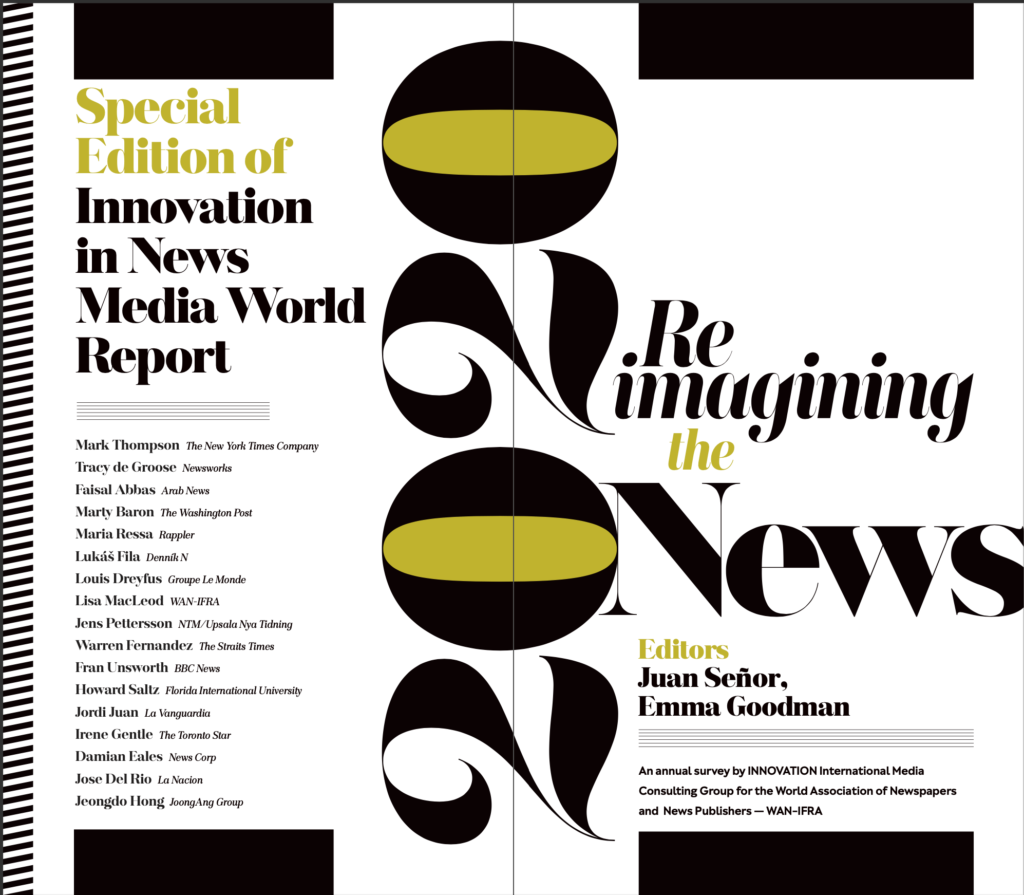
01 Nov The Transformation we are Living Through Today is as Dizzying as it is Exciting
By Jose Del Rio,
Editor-in-Chief of La Nacion,
Argentina
Every day, 24 hours a day, a screen lights up the nerve centre of the newsroom. It is where quick decisions and detailed planning take place, to produce both the stories that generate real-time shockwaves, and those that delight readers with their originality and style. It is an infinite pool of ideas that includes the talent of 356 journalists, the programmed agenda of our daily drone and visualisations that make the complex appear simple. That screen shows what our 330,000 digital subscribers are doing, minute by minute.
On other screens we can track the trends of the moment, and compare the activity of our content and our competitors’ content, along with what’s happening on TV in real time. We even calculate a specific score based on how much time readers engage with our content, how greatly a story interests them and what feelings it elicits. It is not a question of big data, but of smart data.

Our direction is clear: quality journalism on every platform, now and going forward. And this isn’t just an advertising slogan: it means striving for constant improvement, embracing successes and errors, following clues in the search for new formulas, learning to try and fail and start over. This requires important and necessary changes in the way we search for stories, and, above all, how we tell them. It also means evolving according to our readers’ habits: habits that combine time frames, trends, and inputs from the most diverse sources. Silos were destroyed long ago. Vertical divisions have been replaced by horizontal work cells in multidisciplinary teams built around projects and themes. Data flows through different arteries and reaches a heart that remains constant: the newsroom.
Maybe that is why it beats with a consistent and increasingly loud rhythm. By the time the COVID-19 pandemic is just a memory, definitive changes will have taken place. Teams will be strengthened, fewer meetings will be in-person and coordination will no longer require a large nerve centre. Innovation is cooked up in two phases: making the everyday distinctive, and making what is distinctive every day.
This is about building a solid foundation that will make a difference to our journalistic DNA. The transformation we are living through today is as dizzying as it is exciting, and will be even more so in the coming decade. Digital media needs to reach readers promptly with disruptive formulas: it needs to be faster and higher quality, with more verification and without indulging in the growing phenomenon of disinformation or ‘fake news.’ We are forced to follow the changing habits of our audiences, who are increasingly sophisticated and demanding of what they consume on specific platforms at different times of day. That is, no doubt, a fundamental part of our reinvention.
“Although we have found a model that well might sustain local journalism for now, it will not be secured until society tames those tech titans who exert such extraordinary market power.“
From a podcast that wishes its listeners a “good morning” and teaches them to optimize their time, to delve into history or to envision the future, to a newsletter summarizing the ten main stories you need to know before you get to the office. From a TV channel that does not sensationalise in its analysis, to a documentary several months in production released on YouTube. From showing what poverty looks like through the eyes of children, to making change by publishing official data previously kept under lock and key. All of this is produced in ways that trigger emotions, that share states of mind, but that above all expand horizons. New readers will also have other interests and habits: you have to be there to satisfy them, wherever they may be. Today LA NACION has some 40 million monthly individual users and creates between 250 and 270 digital stories every day. But it is not only that. It is no longer a one-way relationship between a broadcaster and a recipient, but a constant back-and-forth that allows us to ascertain the interests of each customer with a high level of precision.
Now 45% of our followers on social networks are under 35, we have more than a million followers on Instagram, 4.1 million between our Facebook accounts and 4 million on Twitter. Content is presented differently according to platform and target age group, and that trend will only intensify. Readers are not all motivated by the same concerns and it is not the same variables that allowed us 150% growth on YouTube in 2019, some 500,000 subscribers to our channel, and more than 2 million plays of our podcast programming.

Technology has made definitive changes to the way people connect, but the fundamentals remain the same. Between past, present, and future there is a common bridge that joins 150 years of history of LA NACION: our values, trustworthy information, and the preponderance of facts over opinions. Also, the diversity of analysis and the belief that understanding reality betters us as a society. We continue to be motivated by our belief in an Argentina with a division of powers, with a stable legal framework, and in which education and culture play fundamental roles. That has not changed throughout our history, and will not change in the future.
Journalism’s mission remains the same: in its essence it is the value of questioning, provoking, and ultimately denouncing situations that are contrary to democratic values. There are countless brave people that carry out this solitary, complex and dangerous task, in which duty towards society overrides personal interests. The future is based on precisely this essence: in fact, it is the cornerstone for constructing it. ●


